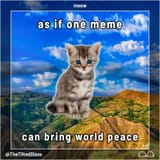The Crossroads of Civilization: Paths Toward Peace
Humanity stands at a turning point unlike any in history. For the first time, our technology can either unite or annihilate us. The threats we face today are not isolated—they’re converging.
1. Techwarfare
The silent war is already here. Cyberattacks, AI manipulation, data theft, and information warfare erode trust in institutions and truth itself. Unlike nuclear weapons, these tools operate invisibly, constantly, and globally. As artificial intelligence grows more autonomous, even a minor miscalculation or algorithmic error could trigger economic collapse or military escalation.
2. Biowarfare and Biotechnology Risks
Advances in genetic engineering and synthetic biology promise cures and abundance—but also the potential for tailored pathogens. The danger isn’t only in deliberate attacks; it’s in accidents, covert experiments, or the weaponization of pandemics through fear and propaganda. Once unleashed, biological threats ignore borders, ideologies, and control.
3. All-Out Warfare
Despite nuclear deterrence, the risk of large-scale war remains real. Rising nationalism, dwindling trust, and automated defense systems create a landscape of hair-trigger instability. The next world war might not begin with an invasion—it could begin with a deepfake, a hacked satellite, or a rogue AI decision interpreted as aggression.
4. Ecological and Economic Collapse
Climate change, resource depletion, and runaway inequality add tinder to the fire. Scarcity breeds desperation; desperation breeds violence. If technology continues to serve profit over people, even abundance can become a weapon—controlled by the few at the expense of the many.
5. Psychological and Spiritual Fragmentation
The deepest threat may not be external but internal. A world saturated with fear, outrage, and misinformation keeps humanity trapped in fight-or-flight. Without meaning, empathy, and purpose, even peace feels hollow—and societies lose the will to preserve it.
1. Techwarfare
The silent war is already here. Cyberattacks, AI manipulation, data theft, and information warfare erode trust in institutions and truth itself. Unlike nuclear weapons, these tools operate invisibly, constantly, and globally. As artificial intelligence grows more autonomous, even a minor miscalculation or algorithmic error could trigger economic collapse or military escalation.
2. Biowarfare and Biotechnology Risks
Advances in genetic engineering and synthetic biology promise cures and abundance—but also the potential for tailored pathogens. The danger isn’t only in deliberate attacks; it’s in accidents, covert experiments, or the weaponization of pandemics through fear and propaganda. Once unleashed, biological threats ignore borders, ideologies, and control.
3. All-Out Warfare
Despite nuclear deterrence, the risk of large-scale war remains real. Rising nationalism, dwindling trust, and automated defense systems create a landscape of hair-trigger instability. The next world war might not begin with an invasion—it could begin with a deepfake, a hacked satellite, or a rogue AI decision interpreted as aggression.
4. Ecological and Economic Collapse
Climate change, resource depletion, and runaway inequality add tinder to the fire. Scarcity breeds desperation; desperation breeds violence. If technology continues to serve profit over people, even abundance can become a weapon—controlled by the few at the expense of the many.
5. Psychological and Spiritual Fragmentation
The deepest threat may not be external but internal. A world saturated with fear, outrage, and misinformation keeps humanity trapped in fight-or-flight. Without meaning, empathy, and purpose, even peace feels hollow—and societies lose the will to preserve it.


